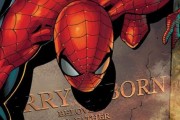This next entry in my little miniseries of spotlights on Superior Foes of Spider-Man characters is an undeniable cheat. I wanted to write about something involving the Beetle, but Janice Lincoln, the female iteration of the character (dubbed “Lady Beetle” in many of my posts) never actually interacted with Spider-Man until the new Sinister Six’s ill-fated first appearance in Superior Spider-Man #1 (Janice made her first full appearance in a 2010 issue of Captain America). So for the purposes of this post, I’m going to go back all the way to the Silver Age and Amazing Spider-Man #21, the first time Spider-Man and the original Beetle (Abner Jenkins – who DOES appear in Superior Foes, so this isn’t a total race) squared off.
So now that I’ve officially broken my own set of non-existent rules in web blogging about a comic book character, I’m going to ruffle some even more feathers in pointing out that Abner-Beetle isn’t even technically a Spider-Man villain.
That’s, of course, a loaded comment in that how does one truly assign a villain to a specific hero? The comic book industry is filled with villains who were introduced in one series, only to become better known for an association with another set of characters. Is Wolverine not truly an X-Men because he was first introduced as an adversary for the Hulk? Was the entire Dark Reign era for the Avengers totally nullified because Norman Osborn is a Spider-Man villain first and foremost and thus is not allowed to be the mastermind of a nefarious plot to rule the world?
But Beetle really, REALLY isn’t a Spider-Man villain. And he’s always come across as a bit of a square peg in a round hole (or is it the other way around?) because of that. The character was first introduced as a foil for Johnny Storm, aka the Human Torch in an issues of Strange Tales (back when Torch would have solo adventures away from the Fantastic Four) and even in Beetle’s first interaction with Spider-Man in ASM #21, the two characters only become embroiled because Spidey is in the wrong place at the wrong time. Stan Lee and Steve Ditko make it plainly clear that Beetle is one of Johnny’s guys, as Abner spends the bulk of the story plotting how he will get his revenge on the Torch. When the villain decides the solution to his problem is to kidnap Johnny’s girlfriend Doris, and Peter happens to already be with her (more on that in a second), a fight breaks out between Spidey and Beetle.
While the Beetle has this big suction fingers, which I guess are a fairly cool power-up (it actually sounds more annoying for a hero to contend with if you want my honest opinion), good old Abner is never really presented as a threat for Spider-Man throughout this comic. In fact, the real drama is the pseudo-love triangle that has developed involving Peter, Johnny and Doris.
At this stage in Spider-Man history, Spidey and Human Torch were still deeply committed to not liking each other. As I wrote about at length in this very prized post on Longbox Graveyard a few years ago, Marvel made a very interesting character choice in taking its two flagship teenage superheroes in Spider-Man and Human Torch and pitting them against each other. Traditionally, comics would take two characters who were similar in one general way (like they were the same age, or lived in the same city) and make them team-up without any complications – ignoring the fact that these characters could be totally different on the personality spectrum. In typical Marvel fashion, the “House of Ideas” ignored convention and decided to make its characters more compelling and relateable by acknowledging what made Peter and Johnny so different. Not only did it make for a far more entertaining character dynamic, but it’s also a clever way to engage a wider swath of readers. I’m sure in the 60s, there were cool wiseguys like Johnny, and quieter, more introverted folks like Peter buying Marvel comics. Stories like ASM #21 let each of these audiences know that there was a character out there for them to identify with. And it’s that kind of risk-taking, probably more than anything else, that transformed so many Marvel characters into phenoms during the 1960s.
But what about the Beetle? Well, that’s just it. Once Doris is abducted and Torch spots Spider-Man swinging off after the Beetle, Johnny doesn’t know whether or not to trust or fight Spidey. And not that Doris is disposable or anything, but the central conflict of the comic morphs into whether or not Spidey and Torch can put aside their differences to save the innocent girl. Doris could have been a police officer, a teacher or an ice cream cone. Ditto for Beetle. Their actual characters were completely irrelevant and just a device to force two characters who otherwise hated each other to work together. And naturally, once the two do put aside their differences, the Beetle is easily disposed of.
From there, the Beetle vanished from the pages of Spider-Man comics for a considerable amount of time, showing up for a story here and there. One of his most significant career choices was being one of the founding members of the Sinister Syndicate, a precursor to the Superior Foes line-up. But he’s never had that Spider-Man story that’s truly defined him as anything other than some guy who wanted to kidnaps the Human Torch’s girlfriend. Maybe if he paid Spidey some attention, a la some actual Spider-Man villains like Doc Ock or Vulture, Abner would have been far more successful in ASM #21. Then again, without his buffoonery, we wouldn’t have the comedic gold which is Mach VII trying to leave a room and breaking down the door, like we get every time he appears in Superior Foes.










This was my first Lee Ditko issue so it’ll always have a special place in my collection.